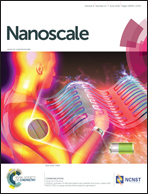Facile synthesis of a mechanically robust and highly porous NiO film with excellent electrocatalytic activity towards methanol oxidation†
Abstract
Considerable research is being conducted in searching for effective anode catalysts in alkaline direct methanol fuel cells (DMFCs). Although significant progress has been achieved, it is still challenging to prepare non-Pt catalysts with both excellent activity and good durability. Herein, a highly porous NiO film is developed by a facile and fast anodization approach. The anodic NiO film demonstrates a high surface area, large mesopore volume and small crystallite size, leading to facilitated adsorption of reaction species, easy electrolyte penetration and fast reaction kinetics. Furthermore, as anodic NiO is grown in situ on a metallic substrate with strong adhesion strength and good electrical contact, it can be used directly as an anode catalyst for methanol oxidation without the need to add any binder or conducting agent. Such an additive-free approach greatly expedites the catalyst preparation process. The anodic NiO shows lower methanol oxidation potential, higher oxidation current and better catalytic durability than most of the state-of-the-art Ni-based catalysts reported elsewhere. As anodization is a simple, low cost and easily scaled up method, the work described here provides an exciting direction to speed up the practical application of alkaline DMFCs.


 Please wait while we load your content...
Please wait while we load your content...